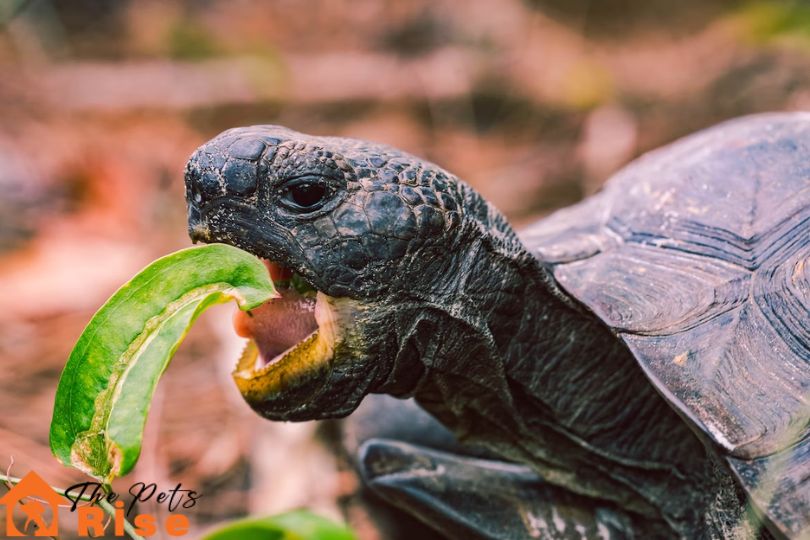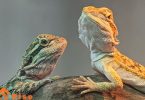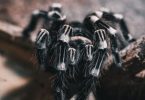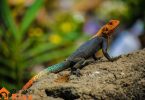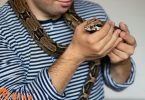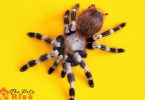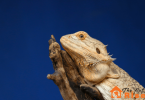Reptile diet is one of the most common concerns among pet reptile owners. Like any regular pet owner, these exotic pets owners also want to keep their health in the best condition. Yes, this includes a diet of reptiles as well. The problem with exotic pets like reptiles is the fact that they have unique diets, unlike dogs and cats finding their diet can be a little hard for new pet owners mainly because they have little to no idea regarding how they should be determining the diet of their pet reptiles such as lizards, spiders or turtles.
So in this guide, we bring you the best information regarding pet reptile diet. So, continue reading the following for a better idea about reptiles feeding. However, before you set the diet for your reptile, make sure you have talked to your pet reptile expert first and line up the reptile feeding schedule.
What Do Reptiles Eat?
The reptile diet is somewhat difficult to understand for newcomers. This requires an understanding of their dietary needs first before feeding them anything. The food of reptiles can be varying because they can be carnivores, herbivores, or omnivores. Carnivorous reptiles feeding, such as snakes and some lizards. They eat live or pre-killed prey such as rodents, insects, fish, or small mammals. Though feeding a lizard insect according to its size shouldn’t be a concern. Make sure not to overfeed them. Herbivorous reptiles, such as tortoises and iguanas, primarily consume vegetables, leafy greens, fruits, and sometimes grasses or hay. Calcium supplementation is important for herbivores.
Reptiles feeding especially omnivorous reptiles like bearded dragons and certain turtles have a flexible diet. This includes both plants and animals. They require a balanced mix of insects, worms, snails, small vertebrates, vegetables, fruits, and greens. It is crucial to research the specific dietary requirements of each reptile species and mimic their natural feeding habits. Monitoring their health, body condition, and appetite is essential. If any significant changes occur due to a reptile diet change, consult a reptile-savvy veterinarian. By providing a suitable diet, reptile owners can ensure the well-being of their scaly companions.
Easy reptile diet Guide
Here is our guide for the diet of pet reptiles.
Bearded Dragons
One of the most common reptiles the bearded dragon is not so picky eater. Bearded dragons are omnivorous reptiles, which means they naturally consume both plants and animals as part of their diet. In captivity, it is common to feed them a combination of insects, vegetables, fruits, and commercial bearded dragon food to meet their nutritional needs. When you will be looking for food for reptiles like bearded dragons then you should be looking for the three main components of a pet bearded dragon’s diet:
– Meats (Insects): Meat requirements for bearded dragons are typically fulfilled by offering them insects. When it comes to feeding a lizard, the Insects are convenient, affordable, and can be “gut-loaded” with high-quality food before feeding them to your lizard. To make such food of reptiles more nutrients you can dust it with supplement powders. They will even be more nutrients than ever.
Young bearded dragons require more protein than adults due to their growth and development. While adult bearded dragons in the wild obtain around 75% of their nutrition from meat sources, pet bearded dragons in captivity, with less exercise, may suffer from obesity if their diet is excessively rich in insects.
– Vegetables/Fruits (Non-citrus): When it comes to the question “what to feed pet lizards” especially when they are adults then things can be a little tricky. Adult bearded dragons should obtain 75% of their nutrition from vegetables and fruits, with the remaining 25% from insects. Citrus fruits, lettuce, spinach, and avocado should be avoided. Fruits should be limited to only 10% of the dragon’s diet due to their high sugar content, or they can be excluded entirely.
Commercially available bearded dragon foods or food of reptiles can also be added to the vegetable and fruit portion of the diet if appropriate. These foods are typically high in protein and fortified with essential vitamins and minerals. Some bearded dragons may be reluctant to eat the hard texture of commercial foods, but they can be beneficial as a dietary supplements.
– Mineral and Vitamin Supplements: Additional mineral and vitamin supplements are available for bearded dragons. Such a diet of reptiles should be dusted with supplements like Nutrobal, and live food (insects) should be gut-loaded and dusted to ensure optimal health. It is important to provide clean, fresh water at all times. If your bearded dragon doesn’t drink much water, you can spray its vegetables with water to increase its hydration.
If you have any concerns about your bearded dragon’s diet or notice any changes in its eating or drinking habits, it is recommended to consult a reptile-friendly veterinarian for assistance. Keep in mind that not all exotic pets are equal but providing them with a well-balanced and varied diet ensures overall health and nutrition is something that all of them deserve so make sure to get them accordingly.
Tortoises
When it comes to a reptile diet such as tortoises, then they are mostly natural grazers that allocate a substantial portion of their day to consuming grass, plants, flowers, and roots, contingent upon the specific species. This dietary preference is characterized by its low fat, sugar, and protein content while boasting a high fiber and calcium composition.
However, when exposed to common vegetables and fruits, which tend to be higher in sugar and protein, tortoises exhibit heightened enthusiasm. Regrettably, these food items are unsuitable for their natural eating patterns and can have adverse effects on their overall well-being. The optimal approach to feeding pet tortoises involves emulating the diet of their wild counterparts, primarily consisting of grasses, weeds, flowers, leafy greens, and herbs.
– What To Avoid: It is generally advised when it comes to food of reptiles that one should steer clear of high-protein vegetables. Like peas and beans, as well as high-sugar options such as fruits and root vegetables should be considered. However, these items should work as occasional treats. In addition to plant matter, it is imperative to supplement their daily diet with calcium, preferably in combination with vitamin D3, and mineral supplements to ensure the tortoise receives all essential nutrients.
Determining The Food: It is worth noting that specific dietary requirements can vary depending on the tortoise species being kept. For instance, Savannah tortoises, such as the Sulcata, primarily graze on grass and hay and require a substantial portion of these items in their diet. Certain tortoises, including the Red-footed tortoise, Yellow-footed tortoise, and box turtle, display omnivorous tendencies and may occasionally consume insects or meat. While it may be tempting to cater to your tortoise’s preferences, such as tomatoes, cucumbers, and lettuce, it is essential to prioritize their nutritional needs over their desires, as many of these preferred foods can have detrimental effects on their health.
If any concerns arise regarding your tortoise’s diet or if you observe any changes in their eating or drinking habits, it is advisable to promptly consult a local veterinarian who specializes in reptiles. Unlike feeding a lizard, feeding young tortoises, can be a daunting task this is because they often fall victim to malnutrition when they are growing up.
This is crucial to provide a controlled and nutritionally balanced diet to promote gradual and healthy development. Even when you provide food for reptiles that don’t suit them just for a week can affect their health. Adult tortoises are also susceptible to health complications. Emerging from a suboptimal diet, including liver and kidney problems, as well as issues related to bone and shell health.
Corn Snakes
When it comes to reptile diet, then one of the tricky diets for newcomers would be feeding a reptile diet. Like many species of pet snakes, Corn snakes are carnivorous reptiles. They require a diet consisting of whole, thawed frozen rodents. Before considering the purchase of a corn snake, it is crucial to feel comfortable feeding them this type of food. While some individuals believe that offering live prey provides a more natural experience for the snake, most captive-bred corn snakes have never been fed live rodents and may reject them. Furthermore, the diet of reptiles like this includes rodents and they pose the risk of injury to the snake and increase the chances of acquiring infections, particularly from wild-caught rodents. According to experts, these rodents should be provided in the deceased form.
What To Care About?
When offering rodents as food, it is important to ensure that the size is appropriate for the snake. Since snakes consume their prey whole, they are unable to manage or may regurgitate food that is too large. The rodents provided should not exceed 1.5 times the size of the corn snake’s midsection. Feeding overly large prey can have detrimental effects.
Feeding Care
Corn snakes do not require frequent feeding. For young snakes, a meal every 5-7 days is sufficient, while adults can be fed every 7-10 days. You can offer thawed rodents as food. But it is crucial to avoid cooking them, as this may discourage the snake from eating or make them ill. Overfeeding shouldn’t be a thing, as snakes, like humans, can suffer from obesity.
What if Your Corn Snakes Do Not Eat?
Sometimes the snakes will not eat food at all and these could be the reasons for this:
– Stress, shedding (snakes do not eat during the shedding process)
– Incorrect vivarium temperatures (it should increase gradually and have hiding places in various temperature zones)
– Inappropriate or “bad” food items are among the factors that can affect a snake’s appetite.
If there are any concerns regarding a corn snake’s eating habits. It is always advisable to seek advice from a veterinarian. They are usually consistent feeders.
In conclusion, ensuring the proper feeding of a corn snake involves providing thawed frozen rodents of suitable size. Avoiding live prey, adhering to legal regulations, and maintaining appropriate feeding schedules. Understanding the reasons behind a snake’s refusal to eat. And always seek professional guidance when necessary is essential for the snake’s well-being.
Conclusion:
The reptile diet is an important part of keeping your pet reptile in good condition. It will also leave a lasting impact on its regular health and growth without a doubt. However, one should have in mind that whether it is about feeding a lizard or thinking about the food of reptiles, make sure that you know the food is accurate enough for their digestion. So it will not have the opposite effect. Though in this blog we have shared a bearded dragon behavior guide which includes its diet guide as well. So you can step further and consult your pet reptile vet before lining up your reptile feeding chart and schedule. They will guide you regarding how and what to feed pet lizards. Enjoy reading our more pet care guides, Happy petting.

